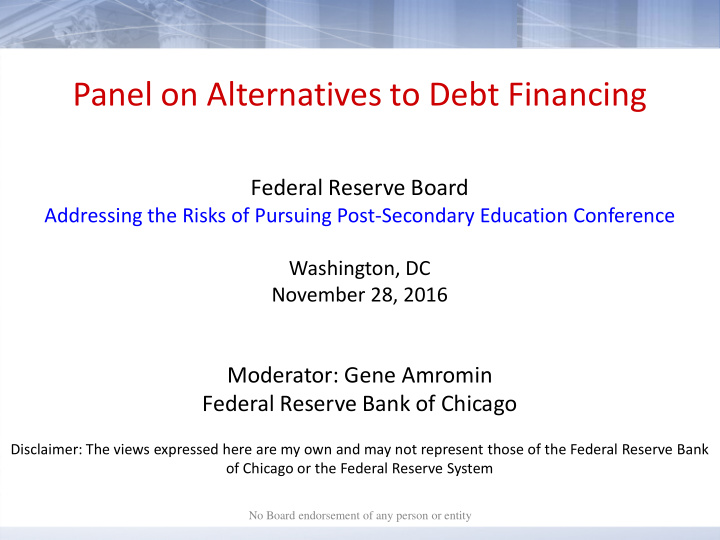



Panel on Alternatives to Debt Financing Federal Reserve Board Addressing the Risks of Pursuing Post-Secondary Education Conference Washington, DC November 28, 2016 Moderator: Gene Amromin Federal Reserve Bank of Chicago Disclaimer: The views expressed here are my own and may not represent those of the Federal Reserve Bank of Chicago or the Federal Reserve System No Board endorsement of any person or entity
Some well-known facts • Student debt has more than quadrupled since 2002 • Multiple reasons for this: – More students (cyclical and secular trends) – Tuition has risen and other funding sources have fallen • State aid • Parental wealth (home equity) • Returns to education, on average, are still high • Yet defaults spiked. Is debt financing partly to blame? – Amount of debt? – Repayment structure? – Incentives for colleges? • Does student debt burden adversely affect graduates’ financial choices and macroeconomic outcomes? No Board endorsement of any person or entity
Some well-known facts: charts Source: The College Board, Trends in Student Aid 2013, Table 7 Source: Mezza, Sommer, and Sherlund (2014) Source: http://www2.ed.gov/offices/OSFAP/defaultmanagement/schooltyperates.pdf No Board endorsement of any person or entity
Let’s talk about some alternatives • Not every family has sufficient wealth/credit to finance college • Is financing higher education through (guaranteed, not risk-priced, non-dischargeable, inflexible) debt the best approach? • Policies to encourage savings pre-college – Address the very need to borrow for college • Contractual form – Fund investment in human capital through equity • State subsidies – Not just amount but also structure • Cannot analyze these approaches while abstracting from the competitive structure of the education sector itself No Board endorsement of any person or entity
Recommend
More recommend